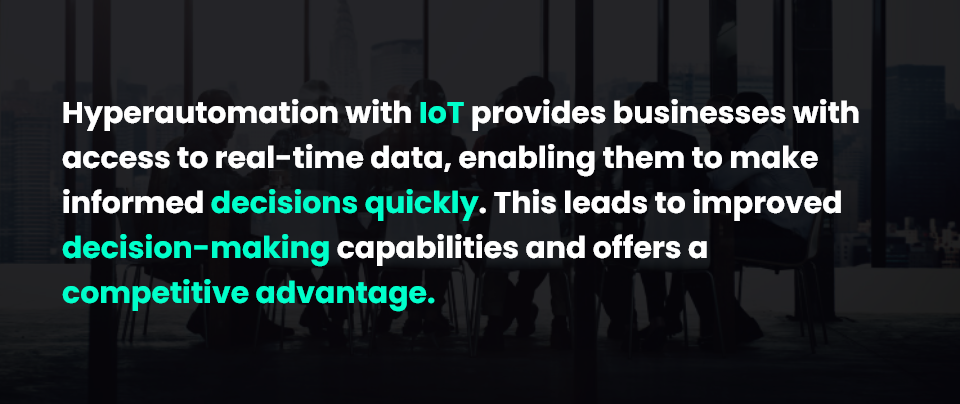With the rise of Industry 4.0, businesses are increasingly turning to automation to streamline their operations and improve productivity. Hyperautomation, the process of automating as many tasks as possible using advanced technologies like artificial intelligence (AI), machine learning (ML), and robotic process automation (RPA), is becoming a game-changer for businesses seeking to stay competitive. The integration of the Internet of Things (IoT) into hyperautomation is further enhancing this transformation by enabling businesses to connect and control a vast network of devices and sensors.
What is Hyperautomation with IoT?

Hyperautomation with IoT involves combining IoT-enabled devices with hyperautomation technologies to create a connected ecosystem that is capable of automating repetitive and mundane tasks.
IoT devices collect and transmit data, while hyperautomation tools analyze this data to make intelligent decisions and automate processes. This integration enables businesses to achieve greater efficiency, improved data accuracy, and enhanced decision-making capabilities.
Hyperautomation is not a single isolated technology but an integration of Artificial Intelligence (AI), Machine Learning(ML), and Robotic Process Automation (RPA) along with IoT sensors connected over a cloud infrastructure. Some interesting facts about Hyperautomation are:
- Hyperautomation was listed as the number one technology trend by Gartner in 2020.
- By 2024, Hyperautomation will reduce operational costs of organizations by 30%.
- The Global hyperautomation market is expected to grow around 9 billion dollars by 2028 at a CAGR of 23.5%.
Benefits of Hyperautomation with IoT

Hyperautomation with IoT offers several benefits for businesses. Here are some of the key advantages:
- Improved Efficiency: By automating processes, businesses can save time and reduce the likelihood of errors. With IoT devices, businesses can track and monitor processes in real-time, allowing for immediate feedback and the ability to make data-driven decisions.
- Greater Connectivity: IoT devices can connect to a vast network of sensors, machines, and other devices, allowing for seamless communication and collaboration between systems. This connectivity leads to greater efficiency and enhanced productivity.
- Enhanced Decision-Making: Hyperautomation with IoT provides businesses with access to real-time data, enabling them to make informed decisions quickly. This leads to improved decision-making capabilities and offers a competitive advantage.
- Cost Reduction: By automating processes, businesses can reduce the need for manual labor, resulting in cost savings. Additionally, IoT devices can help identify areas where efficiencies can be improved, further reducing costs.
Applications of Hyperautomation with IoT
Hyperautomation with IoT has several practical applications across various industries. Here are some examples:
Manufacturing
IoT-enabled devices can monitor and optimize manufacturing processes, reducing downtime and improving efficiency.
Healthcare
Hyperautomation with IoT can improve patient care by automating processes such as medication reminders and monitoring patient vitals.
US healthcare company CVS health introduced hyperautomation as a combination of AI, RPA, ML, data analytics and NLP to streamline the operational tasks like receiving applications, payment transactions, and resolving issues. Earlier these cross functional tasks were done manually involving analyzing a wide range of data.
Retail
IoT devices can track inventory levels and monitor customer behavior, allowing retailers to optimize their supply chain and enhance the customer experience.
Agriculture
IoT sensors can monitor soil moisture levels and weather patterns, enabling farmers to optimize irrigation and reduce water waste.
Challenges of Hyperautomation with IoT
Despite the benefits, hyperautomation with IoT also presents some challenges. Here are some of the key issues:
- Data Privacy and Security: The vast amounts of data collected by IoT devices need to be secured to prevent data breaches and ensure privacy.
- Integration with Legacy Systems: Integrating IoT devices with legacy systems can be challenging and may require significant investment.
- Reliability: IoT devices are vulnerable to connectivity issues, which can impact their reliability and accuracy.
Conclusion
Hyperautomation with IoT is transforming businesses by providing greater efficiency, enhanced connectivity, and improved decision-making capabilities. While there are some challenges associated with this integration, the benefits outweigh the risks, and businesses that embrace hyperautomation with IoT will be at a competitive advantage.
